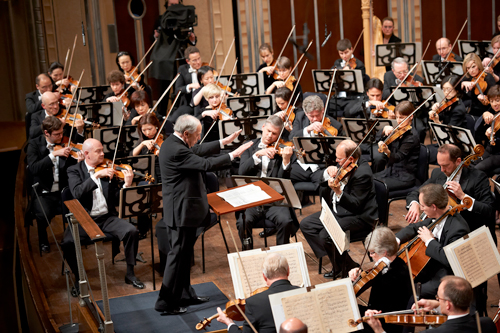by Daniel Hathaway

Cleveland Orchestra Archivist Deborah Hefling laid out the history of Boulez and TCO in an informative talk in Reinberger Chamber Hall before the performance. Then in the main auditorium of Severance Hall, each of the program’s four segments was introduced by video tributes featuring recollections by keyboardist Joela Jones, percussionist Donald Miller, bassoonist Jonathan Sherwin, and first associate concertmaster Peter Otto, including excerpts from Boulez’s charming letters to the Orchestra. To sum up what was said, Boulez was as much admired for his approachability and warmth as a human being as he was for his amazing intellect and clarity as a conductor and composer.
With The Cleveland Orchestra already in place, Jones opened with Boulez’s Twelve Notations for solo piano — a set of miniatures, each of which has a lot to say in a small, concentrated period of time, and which carry evocative performance instructions in their titles (Fantasque; Doux et improvise; Hiératique; Méchanique et très sec; Scintillant; Puissant et âpre). Playing with precision and an acute sense of the drama inherent in each tiny movement, Jones drew the audience into a dozen little, connected worlds. After letting the final note ring into silence, the pianist was called back twice for bows.
Alban Berg’s Three Excerpts from Wozzeck were first heard in Frankfurt-am-Main in June of 1924, a year and a half before the opera was premiered in Berlin (oddly enough, on Christmas Eve!). Boulez introduced them to Cleveland in March of 1970. Drawing on the talents of the excellent mezzo-soprano Michelle DeYoung (a late replacement), Franz Welser-Möst and the Orchestra gave shimmering and often spooky readings of the Lullaby (Act 1, Interlude — Scene 3), the Scripture readings and Marie’s storytelling (Act 3, Scene 1 — Interlude, in the form of seven variations and a fugue), and finally the children’s games after Wozzeck’s drowning (Act 3, end of Scene 4 — Interlude — Scene 5), with thirteen members of the Children’s Chorus singing from the stage right boxes.
DeYoung’s plush voice carried easily through Berg’s often dense orchestration. Though the final scene with the children is most chilling when it comes at the end of the whole opera, the excerpt underlines the beauty and power of Berg’s score, floating as it does above a substructure of strict musical forms and devices.
Claude Debussy’s Jeux, yet another of the astonishing works Serge Diaghilev brought to the dance stage before the Great War, appeared on the first Cleveland Orchestra concert Pierre Boulez conducted in March, 1965. The scenario is — after those other ballet plots — naïve. Three young people search for a lost tennis ball at dusk, with a few minimal side plots. The music scampers about from one idea to another like an inquisitive puppy, but the colors and musical gestures Debussy uses to paint the scene are endlessly engaging. Reprising both Boulez’s debut and his own most recent Cleveland performance of Jeux in 2004, Welser-Möst led a ravishing reading.
There wasn’t a square foot of space left onstage as an expanded Cleveland Orchestra gathered for Boulez’s orchestrations of five of the Twelve Notations to end the concert. Eight percussionists, pairs of extra violas and cellos and an extra double bass helped swell the ranks. The five pieces had grown considerably in length and complexity between their 1945 debut and their final orchestrated version in 1980 and (for Notation VII) in 1997. While the twelve solo piano pieces fly by in ten minutes, the five orchestra works take a quarter of an hour to play.
Played in the order I-VII-IV-III-II, the Notations made a strong impression both for their astonishing complexity (in III, virtually every string player has an independent part) and their utter clarity and intellectual logic.
For some people, this performance would make a strange birthday card, but it capped a perfect tribute to Pierre Boulez.
Photo of Boulez conducting The Cleveland Orchestra by Roger Mastroianni.
Published on ClevelandClassical.com January 20, 2015.
Click here for a printable copy of this article

